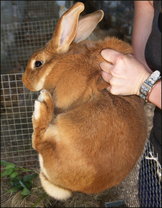
When approaching your rabbitry, talk to the rabbits to let them know that you are coming and that you are not a predator. Always handle your rabbits firmly, but gently.
To pick up an adult rabbit, take the skin behind the ears and over the shoulders firmly in one hand and slip the other hand under its rump (tummy). This leaves the rabbit feeling secure and it will not scratch you. Never pick a rabbit up by the ears. This causes extreme pain.
To carry the rabbit from one place to another, hold it across your body with its head tucked under your elbow. When taking a rabbit out of a cage with a small door, hold it by the scruff and under the rump as if picking it up, and bring it out of cage backwards - with its tail first.
To inspect the underside of the rabbit, hold the scruff, head and ears in one hand. Slip the other hand under the rump and bring the rabbit up against your body. Then gently tip it backwards, supporting it all the way. Do this slowly but firmly and the rabbit will lie on its back without stress.
To catch baby rabbits that are running around, catch by placing a hand over the loins (back) and lift (gently pick them up). To handle little rabbit babies in the nest box, cover the baby with your hand and lift it. Handle small babies as little as possible, but do check every nest box daily and remove wet bedding or dead babies.
Rabbits that are regularly handled learn to trust their handlers and don't scratch or bite when being handled. Each rabbit should be inspected at least once a month for ear canker and to have its toenails cut if necessary.
To check a rabbit’s teeth, turn over as described above and rest the hindquarter on a table or your lap. With two fingers gentle the top lip (which is a split lip) and pull to the side. The teeth become visible and should fit perfectly. If the teeth do not meet properly, the rabbit has a malocclusion (misalignment of the teeth) and should be culled. This cannot be cured and results in the rabbit not being able to eat.